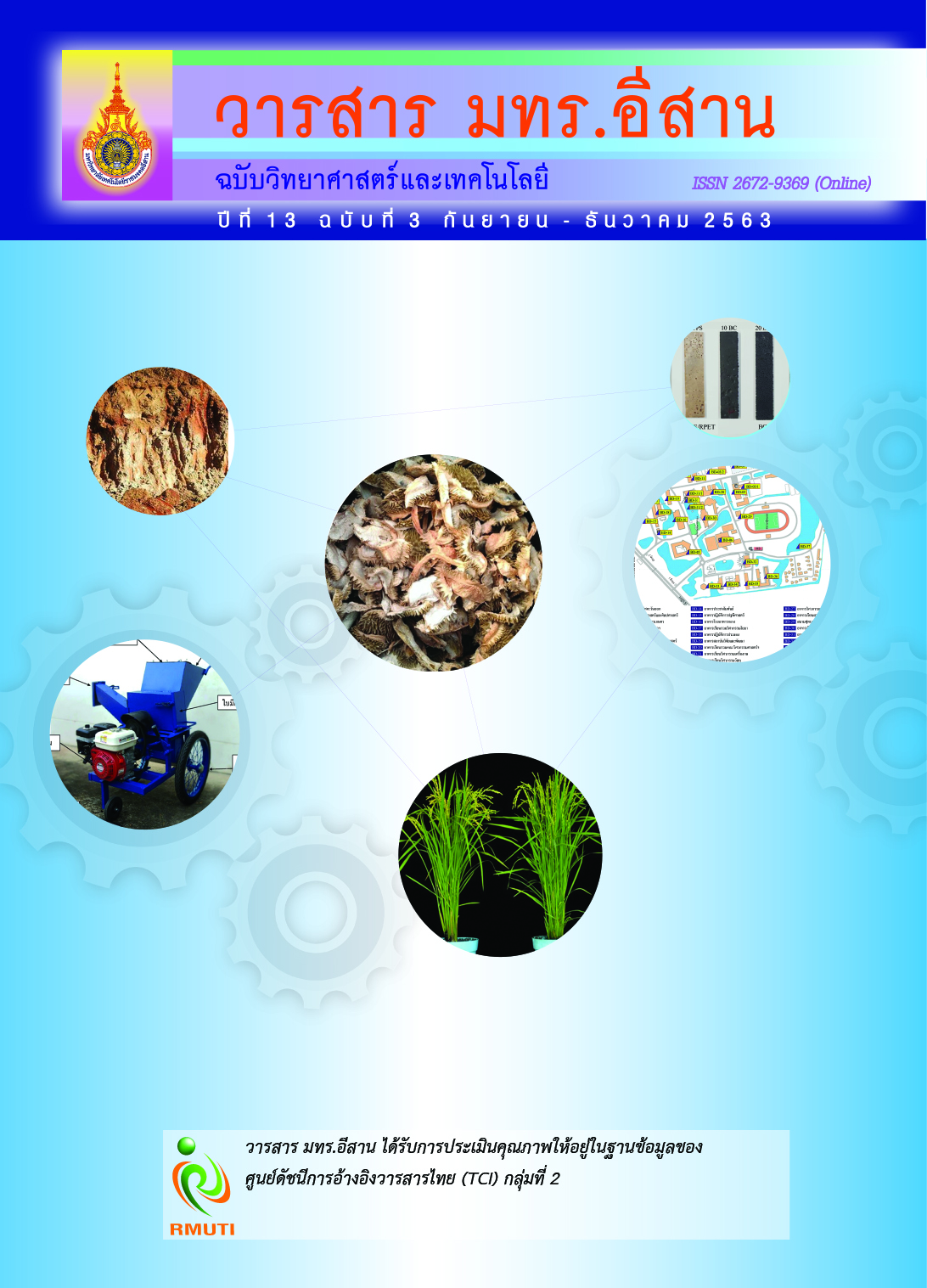Properties of Chiang Khruea Lateritic Soil and Their Applications for Civil Engineering -
Main Article Content
Abstract
Sakon Nakhon is a city-municipality in Thailand whose infrastructure such as highways and buildings have been rapidly developing. Consequently, large amounts of construction materials such as crushed rock, sand, and laterite are being used in many construction projects. Chiang Khruea sub-district contains the main laterite quarries supplying construction sites in Sakon Nakhon province; the extracted laterite from this area is in demand for highway sub-base construction due to its good shear strength after compaction and its low price. However, the properties of Chiang Khruea lateritic soil are not yet maximally used in other civil engineering applications such as landfill liner, backfill material for retaining walls, and as a base layer for paved roads because engineers do not extensively understand its physical and engineering properties. Therefore, this study investigated and reported on the properties of Chiang Khruea lateritic soil to identify possibilities for its applications in civil engineering. The physical (i.e., specific gravity of soil, Atterberg limits, Los Angeles (L.A.) abrasion) and engineering properties (i.e., compacted soil density, California Bearing Ratio, shear strength parameters, permeability (k) and modulus of subgrade reaction) of Chiang Khruea lateritic soil were investigated through a series of laboratory and in-situ tests. The results reported could be useful for engineers as a reference for sustainable design and construction.
Article Details
References
ASTM, D854. (2006). Standard Test Methods for Specific Gravity of Soil Solids by Water Pycnometer. ASTM International
ASTM, D422. (2007). Standard Test Method for Particle-Size Analysis of Soils. ASTM International
ASTM, D423. (1972). Standard Method of Test for Liquid Limit of Soils. ASTM International
ASTM, D424. (1979). Plastic Limit, and Plasticity Index of Soils. ASTM International
ASTM, C131. (2006). Standard Test Method for Resistance to Degradation of Small-Size Coarse Aggregate by Abrasion and Impact in the Los Angeles Machine. ASTM International
ASTM, D698. (2007). Standard Test Methods for Laboratory Compaction Characteristics of Soil Using Standard Effort (12 400 Ft-lbf/ft3 (600 KN-m/m3))1. ASTM International
ASTM, D1557. (2000). Standard Test Methods for Laboratory Compaction Characteristics of Soil Using Modified Effort (56,000 ft-lbf/ft3 (2,700 kN-m/m3)). ASTM International
ASTM, D1883. (2016). Standard Test Method for California Bearing Ratio CBR (California Bearing Ratio) of Laboratory-Compacted Soils. ASTM International
ASTM, D3080. (2011). Standard Test Method for Direct Shear Test of Soils Under Consolidated Drained Conditions. ASTM International
Taylor, D. (1955). Fundamentals of Soil Mechanics. Chapman and Hall Limited, New York
ASTM, D2435. (2011). Standard Test Methods for One-Dimensional Consolidation Properties of Soils Using Incremental Loading. ASTM International
Quang, N. D. and Chai, J. C. (2015). Permeability of Lime- and Cement-Treated Clayey Soils. Canadian Geotechnical Journal. Vol. 52, Number 9, pp. 1221-1227. DOI: 10.1139/cgj-2014-0134
Prongmanee, N., Chai, J. C., and Shen, S. (2018). Hydraulic Properties of Polymerized Bentonites. Journal of Materials in Civil Engineering. Vol. 30, Issue 10, DOI: 10.1061/(ASCE)MT. 1943-5533.0002442
ASTM, D1194. (2003). Standard Test Method for Bearing Capacity of Soil for Static Load and Spread Footings. ASTM International
Chaiyasat, S. (2016). Influence of Clay Content on Permeability of Compacted Lateritic Soil. Engineering and Applied Science Research (EASR). Vol. 43, pp. 1-3. DOI: 10.14456/kkuenj.2016.55
Mahent, R. and Joshi, R. (2015). Improvement Soil Index Properties by Adding Stone Dust Mix. International Journal of Science Technology and Engineering (IJSTE). Vol. 2, Issue 2, pp. 61-68
Jaritngam, S., Somchainuek, O., and Taneerananon, P. (2014). Feasibility of Laterite-Cement Mixture as Pavement Base Coarse Aggregate. Iranian Journal of Science and Technology Transactions of Civil Engineering. Vol. 38, Issue 1, pp. 275-284. DOI: 10.22099/IJSTC.2014.1869
Terzaghi, K. (1943). Theoretical Soil Mechanics. John Wiley & Sons. New York
Department of the Army U.S. Army. (1992). Engineering and Design BEARING CAPACITY OF SOILS. Corps of Engineers Washington, DC 20314-1000
Benson, C. H., Zhai, H., and Wang, X. (1994). Estimating Hydraulic Conductivity of Compacted Clay Liners. Journal of Geotechnical Engineering. Vol. 120, No. 2, pp. 366-387
Prongmanee, N., Chai, J. C., and Shrestha, S. (2018). Effect of Cations on Consolidation and Permeability of Polymerized Bentonite. Lowland Technology International. Vol. 20, No. 3, pp. 297-304
Christopher, B. R. and Stulgis, R. P. (2005). Low Permeable Backfill Soils in Geosynthetic Reinforced Soil Walls: State-of-the-Practice in North America. In Proceedings of North American Geo-synthetics Conference (NAGS 2005). 14 December 2005, Nevada, USA. pp. 14-16


